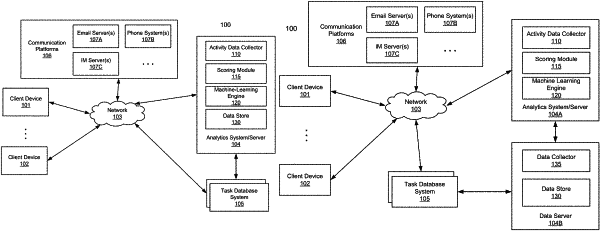| CPC G06Q 10/06393 (2013.01) [G06Q 10/0633 (2013.01); G06Q 10/063114 (2013.01); G06Q 10/109 (2013.01); H04L 67/535 (2022.05); G06N 20/00 (2019.01)] | 20 Claims |

|
1. A computer-implemented method performed at a server having a hardware processor and a memory, the method comprising:
receiving, at the server, a request from a client device to determine a probability of completeness of a first task, the request includes a first task identifier (ID) identifying the first task;
in response to the request, accessing a task database via a first application programming interface (API) to retrieve first task data associated with the first task;
accessing a first communication platform via a second API based on the first task data to retrieve first activity data of a plurality of activities associated with the first task;
generating a plurality of first activity metrics of the first activity data according to one or more predetermined activity categories;
applying an activity scoring model on the first activity metrics to determine an activity score for the first task, including projecting the first activity metrics onto an activity vector to generate the activity score, the activity score summarizing all activity metrics associated with the first task, wherein the activity scoring model was generated by:
for each of tasks in a predetermined set, retrieving activity data of the task from one or more communication platforms associated with the task via respective APIs, the activity data including one or more of email messages sent or received, instant messaging (IM) messages sent or received, past or future calendar events scheduled, or phone calls placed or received,
for each of the tasks, compiling a set of activity metrics according to the one or more predetermined activity categories based on the activity data of the task, and
performing machine learning on the activity metrics of the tasks to train and generate the activity scoring model, including performing an analysis on the activity metrics of the tasks to derive the activity vector, the activity vector representing a distribution pattern of the activity metrics of the tasks;
determining the probability of completeness of the first task based on the activity score of the first task; and
transmitting the probability of completeness of the first task to the client device.
|